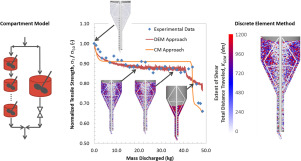当前位置:
X-MOL 学术
›
Powder Technol.
›
论文详情
Our official English website, www.x-mol.net, welcomes your
feedback! (Note: you will need to create a separate account there.)
Computational approaches to predict the effect of shear during processing of lubricated pharmaceutical blends
Powder Technology ( IF 4.5 ) Pub Date : 2018-07-01 , DOI: 10.1016/j.powtec.2018.05.023 William R. Ketterhagen , Matthew P. Mullarney , John Kresevic , Daniel Blackwood
Powder Technology ( IF 4.5 ) Pub Date : 2018-07-01 , DOI: 10.1016/j.powtec.2018.05.023 William R. Ketterhagen , Matthew P. Mullarney , John Kresevic , Daniel Blackwood

|
Abstract In the production of pharmaceutical tablets and capsules, a lubricant such as magnesium stearate is often added to the powder blend or granulation in order to reduce friction and, in some cases, minimize sticking to the manufacturing equipment surfaces. If the lubricated blend is exposed to excessive shear during the processing steps prior to tableting or encapsulation, adverse effects on quality attributes of the final dosage form may be observed. These could include an increase in wetting contact angle, a slowdown in disintegration and/or dissolution, and a reduction in the tensile strength of compacts. In this work, two different computational modeling approaches are proposed to predict the effect of shear during the processing of lubricated pharmaceutical blends on drug product quality attributes. In this case study, an agitated powder feed system is examined, but the approach could be readily extended to other powder processing operations. First, a framework for the prediction of lubrication-based tensile strength reduction using the discrete element method (DEM) is proposed. This approach utilizes a companion study in a lab-scale, high-shear mixer to map the DEM predictions of extent of shear to an experimentally relevant tensile strength prediction. Second, a compartment model (CM) approach is proposed to model the powder flow and lubrication in the feed system. The tensile strength predictions from these two different approaches both compare favorably to experimental measurements of tensile strength.
中文翻译:

预测润滑药物混合物加工过程中剪切效应的计算方法
摘要 在药片和胶囊的生产过程中,经常将润滑剂(如硬脂酸镁)添加到粉末混合物或颗粒中,以减少摩擦,并在某些情况下最大限度地减少对生产设备表面的粘附。如果润滑的混合物在压片或封装之前的加工步骤中受到过度剪切,可能会观察到对最终剂型的质量属性产生不利影响。这些可能包括润湿接触角的增加、崩解和/或溶解的减慢以及压块的拉伸强度的降低。在这项工作中,提出了两种不同的计算建模方法来预测润滑药物混合物加工过程中剪切对药品质量属性的影响。在这个案例研究中,对搅拌粉末进料系统进行了检查,但该方法可以很容易地扩展到其他粉末加工操作。首先,提出了使用离散元方法 (DEM) 预测基于润滑的抗拉强度降低的框架。这种方法利用实验室规模的高剪切混合器中的配套研究,将剪切程度的 DEM 预测映射到实验相关的拉伸强度预测。其次,提出了一种隔室模型 (CM) 方法来模拟进料系统中的粉末流动和润滑。这两种不同方法的拉伸强度预测都优于拉伸强度的实验测量。提出了使用离散元方法 (DEM) 预测基于润滑的抗拉强度降低的框架。这种方法利用实验室规模的高剪切混合器中的配套研究,将剪切程度的 DEM 预测映射到实验相关的拉伸强度预测。其次,提出了一种隔室模型 (CM) 方法来模拟进料系统中的粉末流动和润滑。这两种不同方法的拉伸强度预测都优于拉伸强度的实验测量。提出了使用离散元方法 (DEM) 预测基于润滑的抗拉强度降低的框架。这种方法利用实验室规模的高剪切混合器中的配套研究,将剪切程度的 DEM 预测映射到实验相关的拉伸强度预测。其次,提出了一种隔室模型 (CM) 方法来模拟进料系统中的粉末流动和润滑。这两种不同方法的拉伸强度预测都优于拉伸强度的实验测量。提出了一种隔室模型 (CM) 方法来模拟进料系统中的粉末流动和润滑。这两种不同方法的拉伸强度预测都优于拉伸强度的实验测量。提出了一种隔室模型 (CM) 方法来模拟进料系统中的粉末流动和润滑。这两种不同方法的拉伸强度预测都优于拉伸强度的实验测量。
更新日期:2018-07-01
中文翻译:

预测润滑药物混合物加工过程中剪切效应的计算方法
摘要 在药片和胶囊的生产过程中,经常将润滑剂(如硬脂酸镁)添加到粉末混合物或颗粒中,以减少摩擦,并在某些情况下最大限度地减少对生产设备表面的粘附。如果润滑的混合物在压片或封装之前的加工步骤中受到过度剪切,可能会观察到对最终剂型的质量属性产生不利影响。这些可能包括润湿接触角的增加、崩解和/或溶解的减慢以及压块的拉伸强度的降低。在这项工作中,提出了两种不同的计算建模方法来预测润滑药物混合物加工过程中剪切对药品质量属性的影响。在这个案例研究中,对搅拌粉末进料系统进行了检查,但该方法可以很容易地扩展到其他粉末加工操作。首先,提出了使用离散元方法 (DEM) 预测基于润滑的抗拉强度降低的框架。这种方法利用实验室规模的高剪切混合器中的配套研究,将剪切程度的 DEM 预测映射到实验相关的拉伸强度预测。其次,提出了一种隔室模型 (CM) 方法来模拟进料系统中的粉末流动和润滑。这两种不同方法的拉伸强度预测都优于拉伸强度的实验测量。提出了使用离散元方法 (DEM) 预测基于润滑的抗拉强度降低的框架。这种方法利用实验室规模的高剪切混合器中的配套研究,将剪切程度的 DEM 预测映射到实验相关的拉伸强度预测。其次,提出了一种隔室模型 (CM) 方法来模拟进料系统中的粉末流动和润滑。这两种不同方法的拉伸强度预测都优于拉伸强度的实验测量。提出了使用离散元方法 (DEM) 预测基于润滑的抗拉强度降低的框架。这种方法利用实验室规模的高剪切混合器中的配套研究,将剪切程度的 DEM 预测映射到实验相关的拉伸强度预测。其次,提出了一种隔室模型 (CM) 方法来模拟进料系统中的粉末流动和润滑。这两种不同方法的拉伸强度预测都优于拉伸强度的实验测量。提出了一种隔室模型 (CM) 方法来模拟进料系统中的粉末流动和润滑。这两种不同方法的拉伸强度预测都优于拉伸强度的实验测量。提出了一种隔室模型 (CM) 方法来模拟进料系统中的粉末流动和润滑。这两种不同方法的拉伸强度预测都优于拉伸强度的实验测量。











































 京公网安备 11010802027423号
京公网安备 11010802027423号